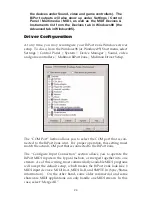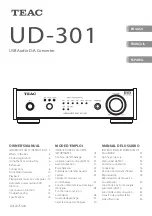
• Outputs MIDI Time Code (MTC) to the host. Whenever the BiPort is
reading or writing SMPTE it will convert the SMPTE information to
MTC. This MTC is transmitted to the host computer via the host seri-
al cable.
• Monitors the host port for SYSEX control information. This is where
commands from the Remote Control software are received.
Functions Shared by Both Modes
Most BiPort functions are available in both MIDI Interface and Stand-
Alone modes. This section describes the operation of each of these
“common” functions.
SMPTE Writer
The SMPTE Writer generates continuous SMPTE and MIDI Time Code.
While writing SMPTE, the “Writing” LED is always illuminated. The
writer may be configured, started and stopped either manually (see
“Write” Button section) or via software. The writer configuration
includes SMPTE output format, start offset, and User Bits. The power-
on defaults for these parameters are 30 fps, 01:00:00:00, and 00 00 00 00,
respectively.
Important: Powering down the BiPort 2x4s will reset all
internally-stored values to their factory defaults.
When the SMPTE Writer is running, the SMPTE reader is disabled. In
fact, the SMPTE writer may override the SMPTE Reader at any time.
While the writer is running, the front panel “Format” button is also dis-
abled. The writer must be stopped before the output format may be
changed.
The Writer is capable of generating SMPTE in five formats: 24fps, 25fps,
29.97fps, 30 drop-frame and 30 non-drop. The 29.97fps format is only
accessible via the Remote Control Software. It is displayed on the front
panel “Format” LEDs as 30fps.
SMPTE Reader
The SMPTE Reader locks to incoming time code, regenerates it to
SMPTE Out (regeneration occurs only in Stand-Alone mode), and con-
verts it to outgoing MIDI Time Code. The SMPTE Reader is capable of
automatically detecting the incoming SMPTE format. When it does, it
9










































